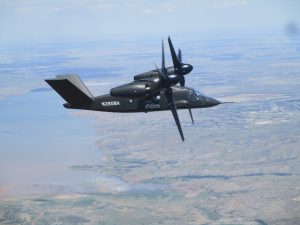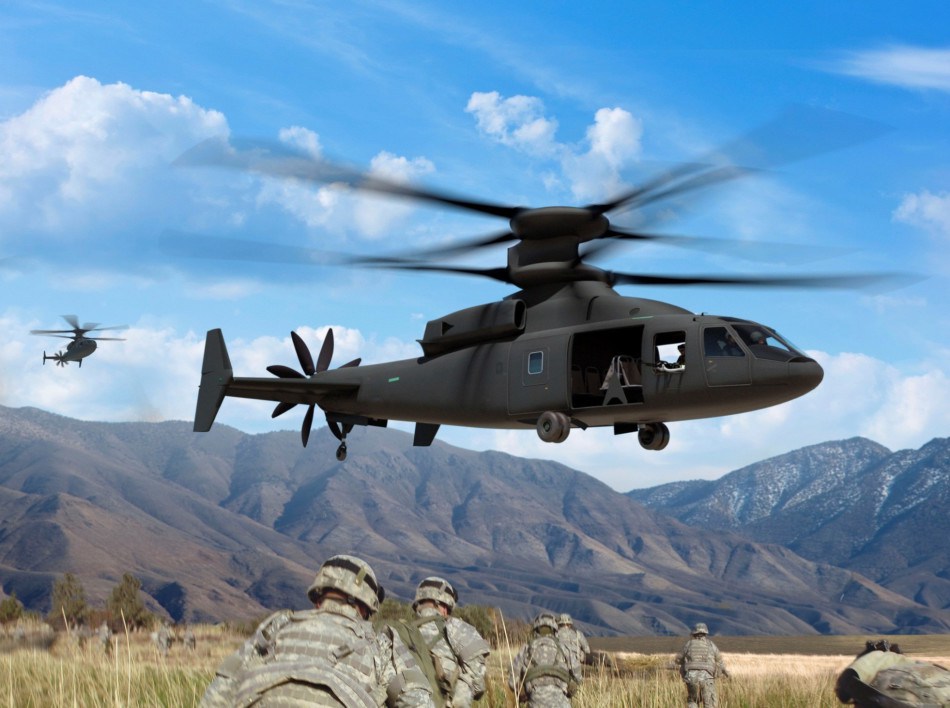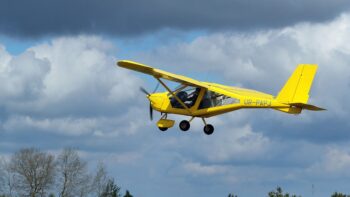WASHINGTON: The SB>1 Defiant, a high-speed helicopter aimed at future Army missions in major wars, won’t make its first flight this year after all. Unspecified but “minor” issues discovered in ground tests will push first flight back “two or three weeks,” co-developers Sikorsky and Boeing said this morning.
Meanwhile, the other contender for the Future Vertical Lift aircraft, Bell’s V-280 Valor, will celebrate a year of flight tests next Tuesday. That reflects, at least in par, a fundamental difference in approach. While Bell’s V-280 uses tiltrotor technology, proven in widespread service on the V-22 Osprey since 2007, the Defiant uses Sikorsky’s revolutionary compound helicopter technology, which promises superior agility — but which has only actually flown in two experimental aircraft, the X2 and S-97 Raider, both of which are much smaller than Defiant.

Bell V-280 Valor tiltrotor in level flight with rotors facing forward. The V-280 is widely considered the leading candidate for the Future Vertical Lift assault aircraft and a contender for the scout version.
Defiant and Valor are both candidates for the mid-sized FVL variant, what the Army now calls the Future Long-Range Assault Aircraft (FLRAA, pronounced “flora”). The Army wants to start building the new assault aircraft ASAP to replace its UH-60 Black Hawks. The UH-60 is a Cold War design that’s been the workhorse in Afghanistan and Iraq, but it lacks the speed and range that military futurists think will be required to penetrate advanced anti-aircraft defenses like Russia’s or China’s. (The Army’s also urgently looking for a new armed scout, the Future Armed Reconnaissance Aircraft, and there the leading contender is Sikorsky’s S-97, which is smaller than Defiant and already in flight testing).
After fixing some “minor” issues discovered during ground tests, the SB>1 will still fly early next year, in plenty of time to provide data to the Army for its ongoing Analysis Of Alternatives, the company officials told reporters. The Defiant and Valor are technically only Joint Multi-Role demonstrators, not competing Future Vertical Lift prototypes, but the Army wants to start a program of record in 2021 and the demonstration phase is widely viewed as a de facto competition.
So when would be too late for first flight? “We haven’t come up with a date that, ‘oh my goodness, if we haven’t flown by this, this time, we’re too late,'” said Randy Rotte, Boeing’s director of cargo aircraft and FVL. “We’ve been really focused on…when we have to have the data to them, which is somewhat fuzzy and open-ended because the Army’s been willing to accept (test data) over a longer period of time.” The crucial data, of course, will come from flight testing: “We’re working with the Army now on how long we’ll be able to do that,” Rotte said.
Inevitable Surprises
What’s been the issue? It is not previously reported problems with the transmission gearbox or rotors, Rotte said. “The good news is, for all intents and purposes, for everything we know, those issues are behind us,” he said. “They were both about manufacturing; they were not about necessarily design.” The gears turned out not to be quite hard enough, so they had to be reground. The unusually long, stiff rotor blades a compound helicopter requires — to achieve high speeds without the crippling vibrations a conventional chopper would encounter — proved “a bigger challenge” than expected to manufacture with the existing tools.
The modified transmission has “been through all its testing (and) passed with flying colors,” Rotte said. The blades have been running in ground tests since last month: “We haven’t seen anything yet that would be an issue or a problem. So far so good, I’m knocking on wood when I say this.”
Whatever the latest issue was, it only appeared when the companies put all the components together and ran them in their Power System Test Bed (PSTB), essentially a copy of the Defiant aircraft that’s bolted to the ground.
“We’ve had a couple of runs on the PSTB,” said Rich Koucheravy, FVL director. for Sikorsky (now part of Lockheed Martin). “The initial two, three runs, we did have some minor discovery. I won’t get into the nature of the discovery, (but) it’s a relatively mundane thing that has to be fixed.”
“We expect these sorts of things to come up when you run a configuration stand for the first time,” Koucheravy said. “That’s the purpose of building the PSTB.” No amount of component-by-component testing or computer modeling can predict all the interactions when you put everything together and turn it on, particularly vibration and heating. But traditionally, you don’t discover those issues until you’ve got the first prototype in ground tests. By building the Power System Test Bed and running it even as the actual aircraft was still under construction, Koucheravy argued, you can find and fix the inevitable problems earlier.
The changes are being made to both the testbed and the Defiant aircraft itself, Koucheravy and Randy said, which is taking about “two to three weeks.” Then the testbed will be back in operation and the Defiant will be starting its first-ever ground tests.
So first flight will likewise be delayed two or three weeks, into early 2019 — assuming no further surprises. “That would be great,” Rotte said. “I’m not sure if that would happen or not.”
The companies could have kludged together something sooner, “a quick fix to get up in the air,” Koucheravy said. “That’s not the type of development work we do.”
Jordan’s Abdullah II defends shootdown of Iranian munitions over its airspace during attack on Israel
Amid Iranian criticisim, “Jordanian leaders have been very clear to portray their action as defensive and in protection of their own sovereignty rather than any act in support of Israel, and this is sincere,” an analyst told Breaking Defense.





























